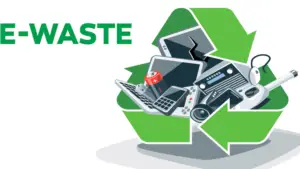
Why in news?
- In our increasingly digitized world, the surge in electronic devices has brought unparalleled convenience but also a significant environmental challenge: electronic waste, or e-waste.
- Recently, the United Nations Institute for Training and Research (UNITAR) unveiled the findings of the Global E-waste Monitor 2024, shedding light on the alarming trajectory of e-waste generation and its implications for global sustainability.
E-waste Generation Trends:
- The report reveals a staggering increase in global e-waste generation, soaring from 34 billion kilograms in 2010 to a daunting 62 billion kilograms in 2022.
- This trend shows no signs of abating, with projections estimating a surge to 82 billion kilograms by 2030. However, only a fraction, approximately 13.8 billion kilograms, is formally collected and recycled in an environmentally sound manner.
Drivers of E-waste Generation:
- Various factors propel this exponential growth, including rapid technological advancements, heightened consumption rates, limited repair options, short product life cycles, and the pervasive culture of disposability.
- Moreover, the burgeoning electronification of societies exacerbates the issue, coupled with inadequate e-waste management infrastructure in many regions.
Informal Recycling Sector
- A notable portion of e-waste, both in affluent and developing nations, is managed by the informal sector due to deficient formal e-waste management frameworks.
- However, this informal recycling often entails hazardous practices, leading to detrimental environmental and health repercussions.
Environmental and Health Impacts:
- Improper e-waste management, particularly through informal recycling, poses grave risks by releasing hazardous substances like mercury and plastics containing brominated flame retardants into the environment.
- These pollutants inflict dire consequences on ecosystems and public health, underscoring the urgency for effective mitigation strategies.
Global Disparities in E-Waste Management and Policy Adoption
- Regional Disparities:
- Europe leads in formal collection and recycling rates, contrasting with Africa’s low recycling rates despite lower e-waste volumes.
- Asia, a major e-waste contributor, struggles with inadequate management frameworks.
- Per Capita E-Waste Generation and Recycling Rates:
- Europe, Oceania, and the Americas exhibit high per capita e-waste generation and commendable recycling rates due to advanced infrastructure.
- Recycling rates for lighter equipment remain low, necessitating tailored interventions.
- Policy Adoption:
- A growing number of countries enact e-waste policies, embracing Extended Producer Responsibility (EPR) and ambitious collection/recycling targets.
- Robust policy frameworks are pivotal in driving systemic change towards a circular economy ethos.
E-waste Management in India:
- In the Indian context, strides have been made to address e-waste challenges through regulatory measures such as the E-Waste (Management) Rules, 2022, which emphasize digitization of management processes, hazardous substance restrictions, and the implementation of a Deposit Refund Scheme.
conclusion
- The Global E-waste Monitor 2024 serves as a clarion call for concerted global action to combat the burgeoning crisis of e-waste.
- By embracing sustainable consumption patterns, enhancing recycling infrastructure, and fostering policy coherence, stakeholders can chart a path towards a more resilient and environmentally responsible future.
- The imperative is clear: the time to address e-waste is now, lest we risk irreparable harm to our planet and future generations.
People also ask
Q1: What is e-waste, and why is it a concern?
Ans: E-waste refers to discarded electrical or electronic devices, posing environmental and health risks due to hazardous components like lead, mercury, and cadmium.
Q2: How much e-waste is generated globally?
Ans: Global e-waste generation reached 62 billion kilograms in 2022, projected to rise to 82 billion kilograms by 2030.
Q3: Which regions have the highest e-waste generation and recycling rates?
Ans: Europe, Oceania, and the Americas exhibit high per capita e-waste generation and commendable recycling rates due to advanced infrastructure.
Q4: Why do disparities exist in e-waste management among different regions?
Ans: Disparities stem from varying levels of economic development, infrastructure, and policy implementation. Europe boasts advanced systems, while Africa and parts of Asia struggle due to inadequate infrastructure.
Q5: What are the environmental and health impacts of improper e-waste management?
Ans: Improper management leads to the release of hazardous substances into the environment, causing pollution and posing risks to ecosystems and public health.